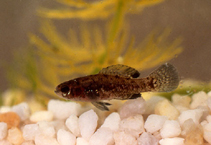Elassoma evergladei Jordan, 1884
Everglades pygmy sunfish
Add your observation in Fish WatcherAquaMaps webservice down at the moment
Upload your photos and videos
Pictures | Google imageElassoma evergladei
Picture by Page, L.M.
Pictures | Google imageElassoma evergladei
Picture by Page, L.M.
Classification / Names Populärnamn | synonymer | Catalog of Fishes(Släkte, Arter) | ITIS | CoL | WoRMS | Cloffa
> Centrarchiformes (Basses) > Elassomatidae (Pygmy sunfishes)
Etymology: Elassoma: Greek, elasson = smaller + Greek, soma = body (Ref. 45335).
More on author: Jordan.
Etymology: Elassoma: Greek, elasson = smaller + Greek, soma = body (Ref. 45335).
More on author: Jordan.
Environment: milieu / climate zone / depth range / distribution range Ekologi
; sötvatten bottenlevande; pH range: 7.0 - 7.5; dH range: 8 - 12. Temperate; 10°C - 30°C (Ref. 1672); 35°N - 27°N
Utbredning Länder | FAO områden | Ekosystem | Förekomster | Point map | Utplanteringar | Faunafri
North America: USA from Cape Fear River drainage in North Carolina to Mobile Bay in Alabama; south in Florida to northern edge of Everglades.
Size / Vikt / Age
Maturity: Lm ? range ? - ? cm
Max length : 3.4 cm TL hane/ej könsbestämd; (Ref. 5723); common length : 2.3 cm TL hane/ej könsbestämd; (Ref. 12193)
Max length : 3.4 cm TL hane/ej könsbestämd; (Ref. 5723); common length : 2.3 cm TL hane/ej könsbestämd; (Ref. 12193)
Occurs in swamps, heavily vegetated sloughs and small sluggish streams, usually over mud. Feeds on worms and crustaceans (Ref. 7020). Oviparous, eggs are deposited in aquatic vegetation, preferably on strands of Ceratophyllum sp. when available (Ref. 58020).
Life cycle and mating behavior Könsmognad | Reproduktion | Lek | Ägg | Fecundity | Larver
Male guards the eggs (Ref. 58020). Produces 40-60 eggs.
Main reference
Upload your references | referenser | Koordinator | Medarbetare
Page, L.M. and B.M. Burr, 1991. A field guide to freshwater fishes of North America north of Mexico. Houghton Mifflin Company, Boston. 432 p. (Ref. 5723)
IUCN Red List Status (Ref. 130435: Version 2024-2)
Least Concern (LC) ; Date assessed: 29 November 2011
CITES
Not Evaluated
Threat to humans
Harmless
Human uses
Fiskeri: kommersiell; Akvarium: Kommersiell
FAO - Publication: search | FishSource |
Ytterligare information
Population dynamics
Tillväxtparametrar
Max. ages / sizes
Length-weight rel.
Length-length rel.
Length-frequencies
Mass conversion
Rekrytering
Abundans
Tillväxtparametrar
Max. ages / sizes
Length-weight rel.
Length-length rel.
Length-frequencies
Mass conversion
Rekrytering
Abundans
Life cycle
Reproduktion
Könsmognad
Maturity/Gills rel.
Fecundity
Lek
Spawning aggregations
Ägg
Egg development
Larver
Larvdynamik
Reproduktion
Könsmognad
Maturity/Gills rel.
Fecundity
Lek
Spawning aggregations
Ägg
Egg development
Larver
Larvdynamik
Anatomy
Gälyta
Brain
Otolith
Gälyta
Brain
Otolith
Physiology
Body composition
Nutrients
Syreförbrukning
Swimming type
Simhastighet
Visual pigments
Fish sound
Diseases & Parasites
Toxicity (LC50s)
Body composition
Nutrients
Syreförbrukning
Swimming type
Simhastighet
Visual pigments
Fish sound
Diseases & Parasites
Toxicity (LC50s)
Human related
Aquaculture systems
Vattenbruksprofiler
Avelslinjer
Ciguatera cases
Stamps, coins, misc.
Aquaculture systems
Vattenbruksprofiler
Avelslinjer
Ciguatera cases
Stamps, coins, misc.
Verktyg
Bio-Quiz | E-book | Fälthandbok | Längdfördelnings-verktyg | Livshistorie-verktyg | Prickkarta | Classification Tree
| Catch-MSY |
Special reports
Download XML
Internet-källor
AFORO (otoliths) | Aquatic Commons | BHL | Cloffa | BOLDSystems | Websites from users | Check FishWatcher | CISTI | Catalog of Fishes: Släkte, Arter | DiscoverLife | ECOTOX | FAO - Publication: search | Faunafri | Fishipedia | Fishtrace | GenBank: genome, nucleotide | GloBI | Google Books | Google Scholar | Google | IGFA World Record | MitoFish | Otolith Atlas of Taiwan Fishes | PubMed | Reef Life Survey | Socotra Atlas | Tree of Life | Wikipedia: Go, sök | World Records Freshwater Fishing | Zoobank | Zoological Record
Estimates based on models
Phylogenetic diversity index (Ref. 82804): PD50 = 0.5156 [Uniqueness, from 0.5 = low to 2.0 = high].
Bayesian length-weight: a=0.00550 (0.00207 - 0.01457), b=3.14 (2.91 - 3.37), in cm total length, based on LWR estimates for this (Sub)family-body shape (Ref. 93245).
Trofisk nivå (Ref. 69278): 3.3 ±0.40 se; based on food items.
Resiliens (Ref. 120179): Låg, lägsta populationsfördubblingstid 4,5-14 år (Fec=25).
Fishing Vulnerability (Ref. 59153): Low vulnerability (10 of 100).




